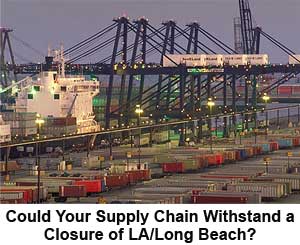How real is the dirty bomb threat? It is very real, according to the study. Radioactive materials are easy to obtain. The International Atomic Energy Agency reports that nearly every country has devices with the radioactive materials needed to build a dirty bomb. Once the materials are in terrorist hands, a dirty bomb can be built by anyone who knows how to build a conventional bomb.
Consequences from a dirty bomb attack fall into three categories. First are the immediate fatalities and injuries that occur from the blast and radiation exposure. Second is the airborne dispersal of the radioactive material and the immediate and long-term effects it has on the exposed population. Lastly is the economic impact the shutting down of a major port would have on our nation, and, from a supply chain point of view, the dent it would put in the movement of goods from one point to another.
The study estimated the length of time a port may be inoperative following a dirty bomb attack into short (15 days), medium (120 days), and long term (one year) closures. The closure of a port following a dirty bomb attack would likely occur due to:
- Dock workers concerned about returning to work.
- Shippers fearful of delivering goods to the harbor.
- The time it takes to decontaminate the site.
 Any of the above reasons for a major port closure would have a tremendous impact on a company’s supply chain. Without dock workers, who will unload the goods? Will the product be safe at a port that has already been terrorized? How long will it take for the EPA to deem the port decontaminated? Any of the above reasons for a major port closure would have a tremendous impact on a company’s supply chain. Without dock workers, who will unload the goods? Will the product be safe at a port that has already been terrorized? How long will it take for the EPA to deem the port decontaminated?
Scenarios estimating the economic impact of a port closure in either Long Beach or Los Angeles, CA calculate that a short-term shut down would result in a loss of approximately $300 million. A medium closure time could result in a significant loss of approximately $63 billion, and a long-term closure up to $252 billion.
The port closure periods and economic losses, of course, are just predictions. The report makes clear no one really knows how long a dirty bomb would close a major port – conceivably, it could be for many years.
As devastating as such an attack would be on U.S. and world economic activity, some companies will be hurt far worse than others. Those that have their entire inbound supply chains tied to Long Beach and related import warehouses, and which do not have clear, executable contingency plans, may find supply chain recovery extremely difficult and expensive.
The report does support investment in a number of “countermeasures” at the ports than can help reduce the risk of a dirty bomb attack.
For example, the report notes that “our analysis clearly supports ongoing programs to install radiation detection technology around the harbor. In addition, the analysis raises concerns regarding the security risks associated with cargo material as it is offloaded from ships but not yet transported through the portals, incoming containers from the U.S. mainland (by truck, small boat, or air), and harbor perimeter control.”
Is it worth the effort to do contingency plans against the unthinkable – a dirty bomb at a major U.S. port such as LA/Long Beach? Are there many supply chains at serious risk from such a terrorism incident? Let us know your thoughts through the Feedback Button below.
|